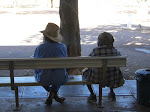Nancy Petyarre ... developed her own style of painting bold works
Nancy Petyarre, 1938-2009
It is difficult to imagine a more unlikely art star than Nancy Petyarre, who did not put a brush to canvas until she was in her 40s. She had no formal education and knew almost nothing of Western art, yet her paintings of the Mountain Devil and Body Paint Dreamings have been exhibited and praised worldwide.

She and her half-sisters, Ada, Myrtle, Kathleen, Violet, Jean and, most notably, Gloria, are among Australia's best known and most prolific Aboriginal artists.
No one kept records when Petyarre was born in the bush at Waite River, about 350 kilometres north-east of Alice Springs, but estimates place her birth date some time in 1938 or 1939.
Her parents, Topsey Pwerle and Mick Kngwarreye, lived traditional lives in the desert, in and around the area that would later be known as Utopia. She grew up speaking the Anmatyerre language.
She had four brothers but was particularly close to her half sisters. As children, they spent hours together in the bush, hunting for tucker.
Before she started painting, Petyarre was a housemaid for cattle stations. She married Sonny Kunoth in the 1950s and had six children, all of them painters.
The women of Utopia had always depicted their Dreaming stories in body paintings and marks in the sand. It was not until the 1970s that they started making more permanent art.
They began with batik and textile work at the suggestion of the area's first art adviser, Jenny Green. Using old hubcaps to boil the dyes, they worked together to make clothing and prints.
Using acrylic paint on canvas did not become popular until 1988 but the Petyarre sisters took to it with enthusiasm. They would sing and chat as they worked, often using sharpened sticks for brushes.
Nancy's first exhibition was a group show at Sydney's S. H. Ervin Gallery in 1989. The next year, an exhibition of the Utopia community's paintings toured Scotland and Ireland.
Despite the growing reputation of Utopia's artists, Nancy Petyarre did not travel outside the Northern Territory until 1993, when she and her family visited her nephew, the art dealer Fred Torres, in Adelaide.
In Adelaide, she saw the ocean for the first time. At night, Torres would take the family to the hills to see the city lights and the dark sea beyond.
During the day they painted in Torres's backyard. For Petyarre, painting was always a communal activity but she soon developed her own style, painting bold works with big brushes. In flowing strokes and bright colours, she painted her country and her Dreaming. Around the blocks of colour, she painted small dots to echo the skin of the mountain devil lizards.
As her fame grew, she travelled around Australia for exhibitions and to meet collectors. Her work has been shown in New York, Copenhagen, Brussels and Pont-Aven, in north-western France. In recent years she travelled to London and Paris.
She is also known for her carvings and wood block prints, represented in the collections of the National Gallery of Australia and the Art Gallery of NSW. Her textile work can be seen at the Powerhouse Museum.
The accolades had little impact on her daily life in Utopia, though the money she earned made it easier to buy food, cars and gifts for the family.
Nancy Petyarre is survived by her brother Clem, her half-sisters Myrtle, Kathleen, Gloria, Jean and Violet and her children Christopher, Trevor, Elizabeth, Carol, Lucy and Helen.
by Louise Schwartzkoff, SMH.com.au
Warning - Aboriginal viewers, this blog may contain images and text of deceased persons.
. We love the wanderer. And we make it easy. If you’d like to explore one or more countries but want to wait until you’re in Europe to decide on the details, no problem. We have the booking expertise to find the ideal combination of passes that will allow you to explore the countries you’d like without confining you to a formal itinerary.
.

















No comments:
Post a Comment